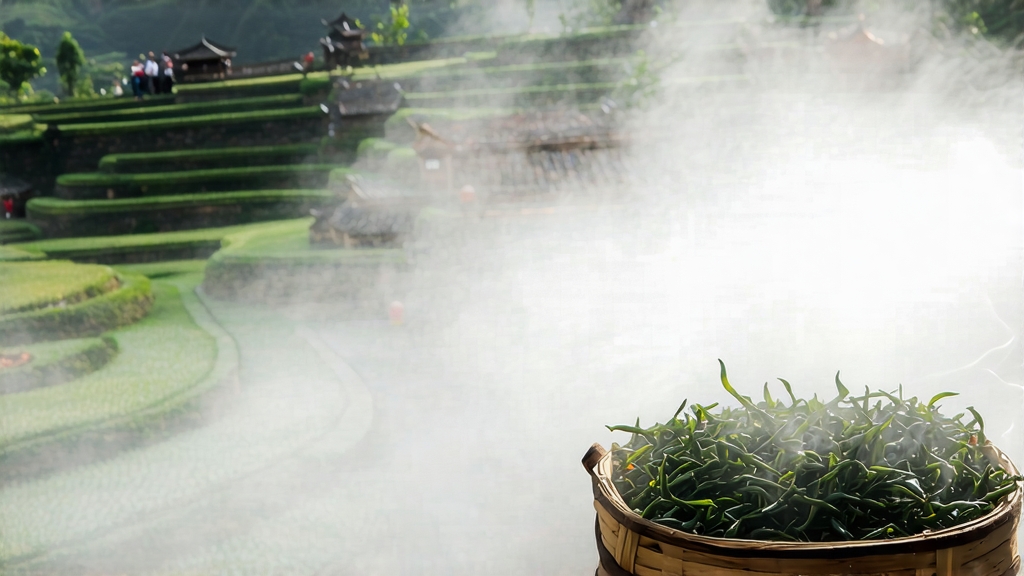
Liu Bao, literally “Six Forts,” is the name of a small township in Wuzhou, Guangxi Zhuang Autonomous Region, yet to tea lovers it denotes one of China’s most intriguing dark teas. Unlike the better-known Pu-erh from Yunnan, Liu Bao has spent centuries in relative obscurity, quietly sustaining traders along the historic Tea-Horse Road and the Pearl River waterway. Today its deep, betel-nut sweetness and mellow medicinal character are winning converts from Kuala Lumpur to Melbourne, making it an ideal ambassador for the broader family of Chinese fermented teas.
History
The earliest written record appears in the 1799 edition of the Gazetteer of Cangwu County: “Dark leaves from Liu Bao, pressed into baskets, relieve summer heat and damp.” By the late Qing dynasty the tea had become a currency of sorts among dockworkers in humid southern ports; a pot was said to “cut the grease” of a rice-heavy diet and ward off malaria. From 1953 to 1993 the China National Native Produce & Animal By-products Corporation ran the only officially licensed Liu Bao factory, supplying miners in Southeast Asia who believed the liquor prevented cholera. When the bamboo-basket export quotas ended, private kilns revived ancient techniques, and Liu Bao entered the era of vintage chasing, with 1970s “Yellow Mark” cakes selling at Hong Kong auctions for more than Pu-erh of the same decade.
Terroir and leaf
Guangxi’s subtropical climate delivers year-round moisture, but the key is the red lateritic soil of the Da Wu Mountains. Tea bushes here—mainly the local large-leaf cultivar Camellia sinensis var. assamica cv. Guangxi—develop unusually thick cell walls, ideal for microbial fermentation. Spring picking follows the rule “one bud, three leaves,” yielding 8-to-12 cm blades that feel leathery even when fresh. Farmers distinguish between “mountain tea” (gao shan cha) grown above 400 m and “river tea” (he pan cha) from alluvial terraces; the former gives higher aromatics, the latter a deeper, taro-like sweetness.
Crafting Liu Bao
The process is a choreography of heat, moisture, and time. After withering for four hours under shaded trellises, leaves are wok-fried at 280 °C for eight minutes to arrest oxidation, then rolled for 30 minutes until the strips turn obsidian. The critical step is “dui wo,” piling 300 kg of hot leaves into a waist-high heap inside a humid room kept at 28 °C and 85 % RH. Over the next fortnight thermophilic bacteria (Bacillus subtilis, Aspergillus niger) bloom, raising the core temperature to 55 °C; workers turn the pile every three days to aerate. Once the leaf surface turns chestnut-brown and emits a sweet betel-nut note, the tea is sun-dried to 10 % moisture, then steamed soft and pressed into traditional bamboo baskets called long lan. These baskets, woven from two-year-old mao zhu bamboo, allow micro-ventilation during the years of warehouse aging that follow. A 30 kg basket stacked in an underground cave at 22 °C and 70 % RH will lose 2 % moisture annually, concentrating flavor while benign molds continue slow fermentation. Aficionados speak of three thresholds: “green age” (1–5 years), “conversion” (5–15), and “medicine” (15-plus), each with its own aroma spectrum from earthy orchid to camphor to ginseng.
Grades and styles
Commercial Liu Bao is graded 1 to 6, with Grade 1 containing the highest ratio of tips and Grade 6 consisting mainly of coarse huang pian leaves. Beyond state grades, boutique producers market “single-tree” lots, “lao cha po” (old-mother) recipes, and “bing” cakes pressed like Yunnan Pu-erh. The most sought-after, however, remain the 1970s and 1980s basket teas whose original wrappers bear stenciled commodity codes: 5101 for standard, 5102 for tip-enhanced, 5103 for large-leaf. A 1979 basket auctioned in 2022 fetched USD 42,000, its liquor described by judges as “black-forest gateau soaked in amontillado.”
Brewing Liu Bao
The tea forgives beginners yet rewards precision. Start with 5 g of leaf